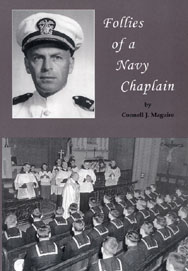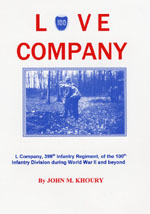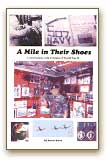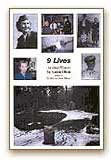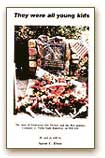Chapter 10
Jack Sheppard's story, Part I
The 712th Tank Battalion worked with three different models of tank. One of the first was the M4A1. Before we became the 712th, when we were in the 10th Armored Division, we were trained on the five-Chrysler straight-eight multibank engine Ė five of them on a tank. They were so bad that we gave all of them to the Russians.
All the air for the air-cooled engine got sucked down through the turret, so in a rainstorm, you got wet, no matter where you were.
In the M4A1, the A designates the engine. The first type of tank we had had only one hatch in the turret for the tank commander. Then they came out with a turret that had two hatches.
The gunner looks either through a telescope or a periscope. Thatís where my tank got hit, on the periscope, so more about the periscope later.
The back of the seats, I donít remember much about them, they were not that terrific. They were just a place to sit when you were tired, and they folded up. Now the tank commander has two seats; one that he stands on when heís looking out the turret. But he also has another seat that he can sit on and look out the turret.
Thatís what I was doing, standing on the bottom with my head sticking out when we got hit. More about that later.
The M4A2 had a diesel engine, and it was powerful. When I was going to officers candidate school, we were out firing on the range practicing firing the 75, and coming back we couldnít get the diesel started. The rest of the tanks pulled off and left us, and eventually we got it started. Weíre coming back from the range on a real nice, wide, good gravel surface, and that speedometer needle was bumping 50. Boy, that thing was rattling. It sounded like you were inside a concrete mixer, but it was rolling. We caught up with them, too.
I wanted to show you this book. I started a couple of years ago writing a biography of myself for my daughter and my son. They wanted to know, "Daddy, what happened to you in your lifetime, especially during the war?" So this is all about the war. This is about my National Guard days before I went in the service. I spent six years in the National Guard, worked my way up to sergeant of the gun section in artillery, and then we were federally mobilized in November of í40 for one year. At the end of that one year, we would go back to civilian life.
In October and November we were on Tennessee maneuvers Ė the 31st Division that was Ė and we had just gotten back to Camp Blanding, where we were getting our equipment all back in shape, and I think one man got released. The rest of us were waiting because on the 7th of December we were going to have a parade in Tampa. The National Guard was going to march with their guns and trucks down to Tampa, through the center of town, and out to the new armory that had just been completed. Well, you know what happened December 7th; that happened on our trip down there, we heard it on the radio, but we still made the parade. Only we never went back to civilian life.
We went to Tampa and went to the fort, and they gave us a couple of hours off to go home and get ready to come back. They were having a dance and dedication ceremony. We came back at 7 oíclock, and the commanding officer got up on the bandstand and announced, "All battery commanders and supply sergeants" Ė I was a supply sergeant Ė "report to the bandshell," and he said, "Iíll give you 45 minutes to say goodbye, get your affairs together."
So we went home, and the newspaper found out about it and the next morning on the front page there was a picture of me and Betty saying goodbye.
We didnít know what was going to happen. We had no idea where we were going. The Japanese had attacked us, so they thought there were Japanese up and down the Atlantic coast and all around the Gulf, there were Japanese everywhere. So we went back to Blanding and did the paperwork, and the next morning, the rest of the troops showed up.
We left Camp Blanding and went due east until we hit U.S. 1. We made a right on U.S. 1. Nobody knew where we were going except the man leading. As we were going south, we picked up our combat team, which was the 155th Infantry out of Jacksonville, and we kept on going, into the night. Around Homestead we stopped and they had a parlay, and from there to Key West they kept dropping off infantry companies to guard the Key West bridges.
Our battery kept going to Key West. U.S. 1 ends at the gate of the fort. So we went into the fort and found out that we were going to be the only coastal defense, because the big 16-inch guns were set in concrete that was rotten and they couldnít fire them because they would blow themselves up. So we were the coast defense with vintage World War I guns. We were in a combat zone, so I got a ribbon for being in an American combat zone, stateside.
When we were at Key West, I got a phone call one night, early in the evening, and it was my wife. I said, "Why, hello, thank you for calling. Where are you calling from?"
She said, "Iím calling from the corner of so and so and so and so."
I didnít recognize the corner, so I said, "Whereís that?"
She said, "Here in Key West!" She was in Key West with our son. Our son was born in í38. She said, "And I need a place to stay."
The battery commander had his car; his wife had driven it down, and was staying there in Key West. We borrowed his car and we found Betty a place to live. We had no money. I was a buck sergeant drawing $52 a month, which doesnít sound like much and it wasnít, but itís more than privates, they were only getting $21. So the battery commander invited Betty to come out to the base to have dinner with them every night, off the cuff of course, and she and our son ate with the officers, and that was all they had to eat. And theyíd tell her to take a few things with her for breakfast and lunch the next day, and come back the next day for dinner. Iíd walk them home and I had to be back at midnight.
I joined the National Guard in í34. Thatís a long time ago. I was 17. It took a waiver of ten pounds to get me in; I think I weighed 118 pounds. I was so skinny, between my hip bones you could have laid a ruler across. But I got in.
My father had a friend who had an old airwing biplane, it had an OX-5 engine, and my father would give him ten gallons of gas and heíd use five of it to give me instructions, thatís all it cost. So the days Iíd take the training, weíd wheel it out of the shed, which incidentally is where Tampa International Airport is now; then it was known as Drew Field. Weíd wheel it out and you had to get up on a ladder and oil Ė the OX-5 had exposed rocker arms, and they worked fast, so you had to oil them every time because there was no oil system for them. So about every hour you had to oil them.
I got in about three hours of training before he had an engine failure. I wasnít in it at the time. The cow pasture he picked out wasnít long enough, and he ran into some trees, and the OX-5 was all wood and fabric, no metal except the engine, it was demolished. He wasnít hurt, but that ended my flying days.
I was interested in the Air Corps pilot training. My wifeís brother was in the same battery I was in. In Key West he applied for pilot training, and I was going to apply but I was three months too old. I was 25; I was born in í16. So he went and he made it and became a P-47 pilot flying coverage over the Hump. Thatís when they were flying supplies with C-47s to China, instead of the Burma Road; we didnít have a Burma Road. He flew cover, and that was flying over the Himalayas. What are they, 24,000 feet? He had to use oxygen. He punctured an eardrum and they retired him.
I waited a little while, and then they came out with a program where you could apply for OCS. I applied for it, but you had to apply for two arms and one service. An arm is artillery, infantry, armor Ė those three were arms, because youíre in contact with enemy, more or less Ė and service is ordnance, quartermaster, those sort of things. I applied for artillery, armor and ordnance. All three of them were within my realm of expertise. I had seen tanks in Louisiana, on the Third Army maneuvers, and they impressed me.
While I was in Camp Bowie, a telephone call came in; my application had been approved for attendance to armored OCS, and I told them Iíd check with the captain and call them right back. I found the captain Ė this was early in the morning, he was shaving Ė and he said, "Sure, go ahead." So I went to OCS in Fort Knox.
Jim Cary was my captain in C Company, when they kicked all us eight-balls out of the 10th Armored. Iím an authority on that.
We got back from the the Tennessee maneuvers and went to Fort Jackson, and I had received an assignment, I think it was First Battalion Headquarters Company of the 11th Armored Regiment. All of the officers were on leave except me; Iíd never been a company commander before, and we got a call from regiment for all company commanders and first sergeants to report up to the meeting hall. So I go up there, and they are reorganizing the battalion. Okay, they read down the rosters, got to So and So, do you want him or do you want to kick him out? Kick him out. Do you want to keep this guy? Thatís what they did.
Yet C Company was a great bunch of men. Iíd take them any day. Man, they were Ö some were, well, everybody was a hero, and some of them were more heroes than others. We had one or two eight balls; I wonít call them cowards, Iíd call them battle fatigue. I even got battle fatigue, lost a week, but I donít think it was from battle fatigue. I think it was one of my headaches. When I got those headaches in those days I went out of my mind. I couldnít do nothing, and Iíd try to beat my head against the wall. It was a concussion headache.
On Hill 122, Abraham Taylor is the only one that I saw, that I know for sure was dead. After my tank was hit and the infantry took that area, I went up, me and the first sergeant went up in a jeep and we looked in the tanks, and thereís nothing in the tanks but ashes down on the bottom. Sometimes you could find dogtags, which was the first sergeantís job; heíd sift the ashes, see if he could find the dogtags, because they didnít burn. It had to be terrific hot, because they were stainless steel. Right next to one tank was a foxhole and in it was Abraham, and he had a rifle leaning over the edge, and he was dead. He had been shot through the head. Quick. But he was the only one I knew for sure was dead. All the rest you wondered about. Did they get out and were taken prisoner, or what?
After that, we were down to seven [out of 15] tanks, and not many men. When the first replacements came on, we werenít wearing any insignias, because the snipers would use them as targets, and the only way you could identify an officer was I had a white stripe, about an inch and a half long and about four inches wide, down the back of the helmet. If it was up and down it was an officer. If it was sideways it was a sergeant.
These recruits walked up to us, and one of them looked at me and said, "Hey, Mac, what in the hell happened to you?" And the first sergeant said, "Shut your mouth, thatís a company commander!" That must have made their day. If a company commander can get looking like that, whatís going to happen to them? I still had my combat jacket, and it had bloodstains on it. And my face was bandaged, my hand was bandaged, and I still had the most glorious black eye, you know what a mouse is? I had two of them after that from the concussion.
There are only three unit citations in the 712th. One of them is for the first platoon, C Company, on Hill 122. I was with it at the time. The reason they got it was because the battalion of infantry got it, and their attached units get it; thatís the way we got it.
Okay, we take Hill 122. Going down off the hill was another story.
Iím taking this tank to Jim Flowers; itís one of his tanks that had been knocked out and we got a replacement for. He only had three tanks, and this would give him four.
Going up the hill, it was raining. The Signal Corps had their wires strung alongside the hill, and we had to contact them to come and hold the wires back in case the tanks started slipping, because if a tank slipped into the wires the tracks would just chew up the wires. We got hell for that when somebody else went up there and chewed them up.
We got up on the top of the hill and we were going down towards Flowers when a lieutenant colonel stopped me. I was in a jeep leading the tank, with Jim Bailey as my driver. This colonel said, "I need some tanks down there. Iíve got a battalion thatís surrounded by SS and they need tank support but bad."
I said, "Let me see if I can get Flowers released." He was down with another battalion.
I called the division commander, and he by voice authorized me, so I called up Flowers, and he came back and joined us. And when I talked to him I said, "Thereís only three men in the tank; you need a driver and you need a commander, so Bailey will take over as driver and Iíll take over as commander, but you are the platoon leader. Iím just another tank in your platoon."
He said, "Okay. You follow behind Taylor." So they pulled out in front of me and we pulled along behind them.
Flowers fired the machine gun a few times, and all of a sudden we were with this battalion. Then we were given orders that weíre going to attack across the road. The road went past a big open field with a hedgerow at the far end. Flowers and K Company of the 358th Infantry Battalion were going to take that hedgerow. Famous last words.
We pulled up to the road, all in a line, and fired at the hedgerow with the cannon and the machine gun, just raked it, and high-explosive, all to hell. Then the platoon leader of the infantry gets out here and says, "Letís go!" So we all go, tanks and infantry Ė usually the infantry behind the tanks.
We just get across that road, and my tank hits a hog wallow Ė a mud hole Ė and tips over. All it would do was that right track would just spin, no traction whatsoever. So we were just sitting there.
I had my head out the turret. You always had your head out unless you were being shot at. I had my carbine in my hand, in case I saw something.
About that time, the tanks disappeared over the hedgerow. Then a round came in from the right and hit the gunnerís periscope, and blasted straight on through to the other side of the tank. Back in the corner is our little joe, which was our gasoline motor; it was a generator, to keep the battery up. That was shredded. All of the recoil cylinders in the gun had holes punched in them, so the gun couldnít be fired.
The radio, which was in the back of the turret, was full of holes, and it didnít work. So we had no reason for staying in the tank, and Louis Gerrard has his right eye hanging on his cheek; he was in bad shape. He was not unconscious, but he was in extreme pain. He was non compis mentis, I guess youíd put it. So we all got out and got behind the tank, and they were looking after him, and I had, my face was blasted, I was leaking blood all over my face, and we were trying to figure out what to do. I said, "Iíll tell you what. You all stay here and take care of his wounds, and Iíll go back across the road, to see if I can get a stretcher and send it back." I did that. But while I was jogging back, my jaw was flopping up and down; I had a piece of shrapnel, how big is your thumb? Can you see the scar right there? It went through and knocked a tooth out, but it stayed right there.
So I pulled it out and put it in my pocket. I was going to keep it; I donít know what ever happened to it. I found a medic and sent him and a stretcher back up. But before he got there, one of the other guys from the crew found me. He said two German SS men had come up and Bailey started to fight with them, and they killed him. I donít know how, but they killed him. And the other two guys played dead and let the Germans search them and take their watches and so forth; they didnít bother the injured men, I donít think.
I was under the impression at the time that the medics had brought him [Gerrard] back, or I would never have left him. Because that tank was accessible. It was just across the road and you could get to it. Flowersí tank was across the next hedgerow, which was enemy territory. This was no manís land.
Some infantrymen there said, "Hey, didnít you know that they were shooting at you?" They said two rounds, with tracers, went over my tank before the third one hit. I never saw them. Never heard them. And then they said, "Did you see those on fire up ahead?" Thatís when I first noticed the three columns of smoke.
Thatís the way that happened, and now right there, we go down this road just a little bit, and it hits a T, and someplace along in here is where they put a monument with a listing of the nine people killed.
![]() Contents
Chapter 11, Jack Sheppard, Part
2I
Contents
Chapter 11, Jack Sheppard, Part
2I![]()

